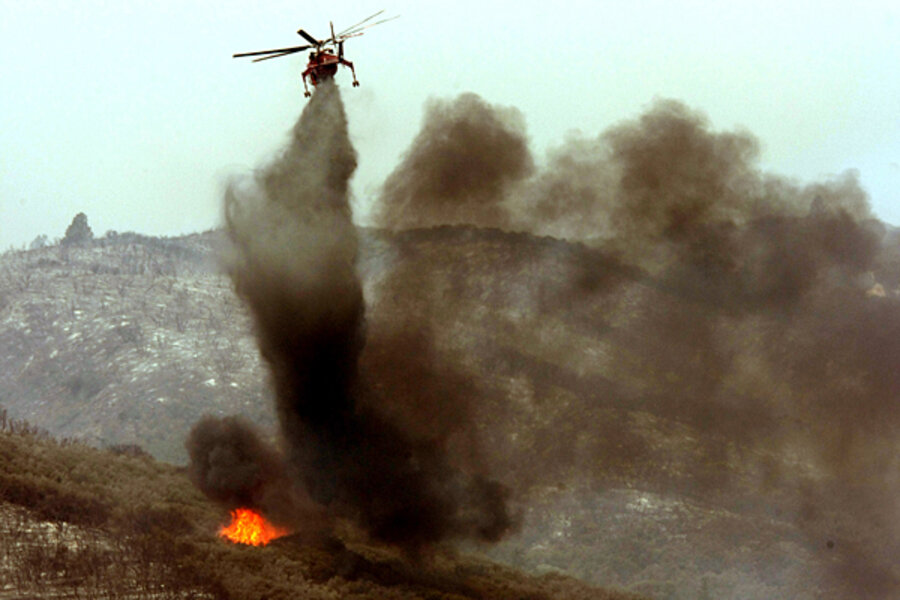Powerhouse wildfire north of L.A. heralds a much longer fire season
Loading...
| Los Angeles
The Powerhouse fire, which erupted in scrub-covered rugged terrain north of Los Angeles and has blackened 30,000 acres, destroyed 6 homes, and forced the evacuation of thousands of people, is dramatizing the challenges facing states across the West, including a much longer fire season, analysts say.
The Powerhouse fire started last Thursday afternoon and now has 2,200 firefighters battling it on foot, vehicles, and in the air. It spread quickly, feeding on the several-decades-old scrub covering the area’s hills and canyons.
As of Monday morning, authorities said, the fire was 40 percent contained. Officials estimated the fire would not be fully contained for another week. Temperatures Monday were expected to climb into the mid-80s with wind gusts up to 45 mph in the hills and valleys south of Lake Hughes.
Analysts said the large early-season fire creates an opportunity to raise awareness about a long list of issues facing localities, states, and the federal government. Those range from man’s contribution to climate change, to choices of where to build homes, to what safety precautions to take in building those homes and how to enforce them.
Given that as a global society we are not seriously addressing climate change, says Dominik Kulakowski, adjunct professor of biology at Clark University Graduate School of Geography in Worcester, Mass., one good question is, “Is this the new normal?” The public, he says, should conclude not merely that this fire season is predicted to be longer, but that such longer seasons will continue for the foreseeable future.
“A lot of the public seems to be saying, ‘oh, well, we’ll just have to keep planting forests [to replace burned areas] in more northern climes,’ that it will play out gradually and we’ll have time to adapt,” says Professor Kulakowski, who in April testified before Congress on the impact climate and weather have on fires. “But the overwhelming conclusion of research is that the [climate] change will be more dramatic and abrupt,” he says.
Don Smurthwaite, spokesman for the National Interagency Fire Center in Boise, Idaho, says the Powerhouse fire should be taken as a sign in California that communities must get prepared for a much longer than usual fire season, and take steps to clear brush around their homes and communities.
“To me, the real story is that this is going to go on through July and August, which will deplete resources by then,” says Smurthwaite. “There’s simply no excuse now not to make great efforts to be preventive.”
He says the ability of different states to coordinate the logistics of personnel and equipment has been refined in recent years with the growth in the number of huge, mega-blazes. That can be measured in the statistic that 19 out of 20 fires are contained by first responders.
“We’ve gotten really good at containing the fires by the first forces on the site,” says Smurthwaite.
In California, where population growth has averaged more than 600,000 a year for at least a decade, housing has pushed into rural areas, which make them more prone to fast-moving wild fires.
"We are increasingly building our homes ... in fire-prone ecosystems," says Clark’s Kulakowski. Doing that "in many of the forests of the Western US ... is like building homes on the side of an active volcano."
Jennifer Jones, a spokeswoman for the US Forest Service, says firefighting resources currently are not particularly strained because the rest of the country is below the 10-year average for fires. But that could change in coming months.
So far this year, about 18,207 wildfires nationwide have burned approximately 307,321 acres, compared with the 10-year average of about 30,372 wildfires burning approximately 1,313,612 acres by this date.
“When something like this happens, a lot of attention gets paid to the response – how many firefighters and helicopters are being sent in – but the fire service is trying to emphasize how important it is for communities to do all the kinds of things that can make these fires easier to contain and fight before the responders get there,” says Jones.







